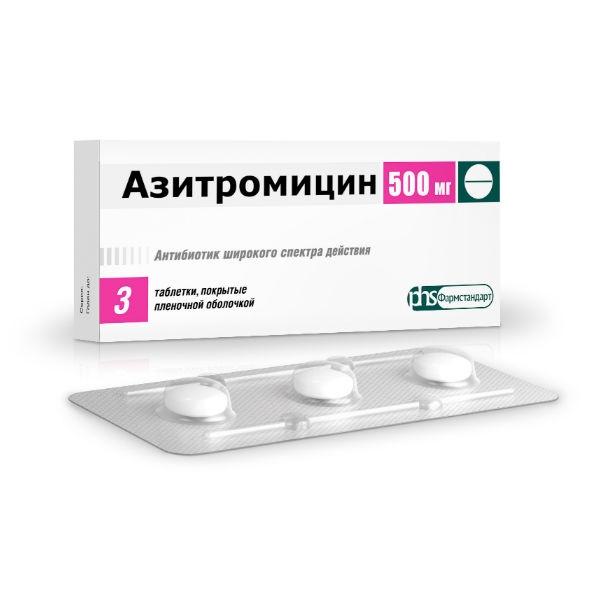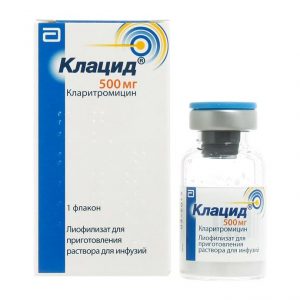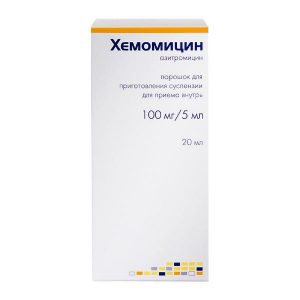Description
Latin name
Azithromycin
Release form
Film-coated tablets of white or almost white color, round, biconvex in cross section, the core is white or almost white.
Packaging
3 tablets (for a dosage of 500 mg) in a blister strip packaging made of a film of polyvinyl chloride and varnished aluminum foil.
Pharmacological action
Broad-spectrum antibiotic. It is the first representative of a new subgroup of macrolide antibiotics – azalides. When creating high concentrations of inflammation in the focus, it has a bactericidal effect.
Gram-positive cocci are sensitive to azithromycin: Streptococcus pneumoniae, Str.pyogenes, Str.agalactiae, streptococci of CF and G groups, Staphylococcus aureus, S. viridans gram-negative bacteria: Haemophilus influenzae, Moraxella catarrhalistiss Bordellis, Bordellis pseudoris, Bordellis Bordea, .ducrei, Campylobacter jejuni, Neisseria gonorrhoeae, and Gardnerella vaginalis, some anaerobic microorganisms: Bacteroides bivius, Clostridium perfringens, Peptostreptococcus spp as well as Clamydia trachomatis, Mycoplasma pneumoniae, urelamdrumlama Tremulma bramidlama Azithromycin is inactive against gram-positive bacteria resistant to erythromycin.
Indications
Infectious and inflammatory diseases caused by microorganisms sensitive to the drug, including:
² Ñ upper respiratory tract infections and ENT organs (sinusitis, tonsillitis, pharyngitis, otitis media)
² Ñ lower respiratory tract infections (pneumonia, including bronchitis caused by atypical pathogens, including acute, exacerbation of chronic)
² Ñ urinary tract infections caused by Chlamydia trachomatis (urethritis, cervicitis)
² Ñ skin and soft tissue infections (Lyme disease (initial stage – erythema migra ns), erysipelas, impetigo, secondary pyodermatoses, acne vulgaris (acne) of moderate severity).
Contraindications
Hypersensitivity to azithromycin and other macrolides hypersensitivity to other components of the drug hypersensitivity to erythromycin, ketolides severe hepatic impairment: more than 9 points on a Child-Pugh scale severe renal impairment: creatinine clearance less than 40 (K) ml / min children under 3 years of age (for tablets of 125 mg), children under 12 years of age with body weight up to 45 kg (for tablets of 250 and 500 mg) simultaneous administration of ergotamine and dihydroergotamine.
Caution
For impaired liver function of mild (5-6 points on the Child Pugh scale) and moderate (7-9 points on the Child Pugh scale) severity of impaired renal function of the lung (creatinine clearance (CC) 60-89 ml / min) and moderate (CC more than 40 ml / min) severity in patients with proarrhythmogenic factors (especially elderly patients): in patients with congenital or acquired prolongation of the OT interval, in patients with risk factors for prolonging the OT interval (receiving antiarrhythmic therapy classes (quinidine, procainamide), (Dofetilide, amiodarone and sotalol) cisapride. While receiving terfenadine, warfarin, digoxin, antipsychotics (pimozide), antidepressants (citalopram), fluoroquinolones (moxifloxacin, levofloxacin), impaired cyclosporin with water and electrolyte balance, especially in the case of hypokalemia or hypomagnesemia, with clinically significant bradycardia, cardiac arrhythmias, or severe heart failure) with pregnancy myasthenia gravis.
Use during pregnancy and lactation
The use of the drug during pregnancy is only possible if the intended benefit to the mother outweighs the potential risk to the fetus.
If necessary, the appointment of the drug during lactation should stop breastfeeding.
Composition
1 tab. azithromycin (in the form of dihydrate) 500 mg
Excipients: microcrystalline cellulose – 36 mg, lactose monohydrate – 33.464 mg, povidone (K-30) – 26 mg, crospovidone – 26 mg, sodium lauryl sulfate – 1. 3 mg, colloidal silicon dioxide – 6.6 mg, magnesium stearate – 6.6 mg.
The composition of the film membrane: hypromellose – 12 mg, talc – 4 mg, titanium dioxide – 2.2 mg, macrogol 4000 – 1.8 mg.
Dosage and administration of
Inside, at least 1 hour before or 2 hours after eating 1 time per day.
Adults and children over 12 years old weighing more than 45 kg (Azithromycin 250 and 500 mg tablets):
For infections of the upper and lower respiratory tract, ENT organs, skin and soft tissues (except for the initial stage of Lyme disease (erythema migrans) and moderate acne) – 500 mg per day for 1 dose for 3 days (course dose – 1.5 g).
At the initial stage of Lyme disease (erythema migrans) – 1000 mg per day on the first day at a time, then 500 mg per day daily from 2 to 5 days (course dose – 3 g
).
When acne is indicated, ordinary (acne) of moderate severity on the 1st, 2nd and 3rd day of treatment, take 500 mg once a day, then take a break from the fourth to the seventh day, from the eighth day of treatment take 500 mg once a week in
for 9 weeks. Course dose 6.0 g
For infections of the urinary tract caused by Chlamydia trachomatis (urethritis,
cervicitis) for the treatment of uncomplicated urethritis / cervicitis, a dose of 1000 mg is prescribed once.
Children from 3 to 12 years old weighing up to 45 kg (Azithromycin 125 mg tablets):
For infections of the upper and lower respiratory tract, ENT organs, skin and soft tissues – based on 10 mg / kg of body weight 1 time per day within 3 days.
With pharyngitis / tonsillitis caused by Streptococcus pyogenes – 20 mg / kg once a day for 3 days (course dose of 60 mg / kg). The maximum daily dose is 500 mg.
When treating the initial stage of Lyme disease (erythema migrans) – 20 mg / kg 1 time per
day on the first day, then at the rate of 10 mg / kg 1 time per day from day 2 to 5 (course
dose of 60 mg / kg) .
In case of impaired renal function.
When used in patients with mild renal impairment
, dose adjustment is not required.
In case of impaired liver function.
When used in patients with impaired liver function of mild to moderate severity, dose adjustment is not required.
Elderly patients.
Dosage adjustment is not required when used in elderly patients.
Side effects
Most of the reported adverse reactions are reversible after completion of treatment or discontinuation of the drug.
Classification of the incidence of side effects (WHO): very often (with a frequency of more than 1/10), often (with a frequency of at least 1/100, but less than 1/10), infrequently (with a frequency of at least 1/100, but less 1/100), rarely (with a frequency of at least 1/10000, but less than 1/1000), very rarely (with a frequency of less than 1/10 000), including individual messages.
From the circulatory and lymphatic systems: often – lymphocytopenia, eosinophilia infrequently – leukopenia, rarely neutropenia – thrombocytopenia, hemolytic anemia.
From the central nervous system: often – dizziness, headache, paresthesia, impaired perception of taste, anorexia infrequently – anxiety, nervousness, hyposthesia, insomnia, drowsiness rarely – agitation, delirium, hallucinations very rarely – fainting, convulsions, psychomotor hyperactivity, aggression, anosmia, loss of taste, parosmia, aggravation of myasthenia gravis, perversion obon.
On the part of the sensory organs: infrequently – hearing impairment, vertigo, visual impairment unknown frequency – hearing impairment, including deafness and / or tinnitus.
From the respiratory system and ENT organs: infrequently – shortness of breath, nosebleeds.
From the cardiovascular system: infrequently – palpitations, “flushing” of blood to the face is very rare – decreased blood pressure, arrhythmia, ventricular tachycardia, increased QT interval, pirouette type arrhythmia.
Infectious diseases: infrequently – rhinitis, respiratory diseases, pharyngitis, pneumonia, candidiasis, including the mucous membrane of the oral cavity and genitals, gastroenteritis.
From the digestive system: very often – nausea, diarrhea, abdominal pain, flatulence (bloating), often – vomiting infrequently – belching, dysphagia, gastritis, constipation, dry mucous membrane of the oral cavity, ulcers of the oral mucosa, increased secretion salivary glands are very rare – discoloration of the tongue, pseudomembranous colitis, pancreatitis.
From the side of the liver and biliary tract: infrequently – hepatitis, hyperbilirubinemia, increased activity of liver transaminases very rarely – cholestatic jaundice, liver failure (in rare cases with fatal outcome, mainly due to impaired liver function), fulminant hepatitis, liver necrosis .
Allergic reactions: often – itching, rash infrequently – Stevens-Johnson syndrome, photosensitivity, urticaria rarely – anaphylactic reactions (including angioedema) in rare cases with fatal outcome, toxic epidermal necrolysis, erythema multiforme.
From the skin and subcutaneous tissues: dry skin, dermatitis, sweating.
From the musculoskeletal system: often – arthralgia infrequently – osteoarthritis, myalgia, neck pain, back pain.
From the genitourinary system: infrequently – increased residual urea nitrogen and plasma creatinine concentration, dysuria, renal pain, metrorrhagia, testicular dysfunction is very rare – interstitial nephritis, acute renal failure.
Other: often – weakness infrequently – chest pain, peripheral edema, asthenia (malaise, feeling tired) infrequently – swelling of the face, fever.
Laboratory data: often – increase in the number of basophils, monocytes, neutrophils, decrease in the concentration of bicarbonates in blood plasma infrequently – increase in the activity of alkaline phosphatase, increase in chlorine, increase in glucose concentration, increase in the concentration of bicarbonates in blood plasma, increase in the number of platelets, increase in hematocrit, change the content of sodium in blood plasma, a change in the concentration of potassium in the blood plasma.
Any side effect should be reported to your healthcare provider.
Drug Interaction
Antacids (aluminum and magnesium) do not affect the bioavailability of azithromycin, but reduce its maximum blood concentration by 30%, so the drug should be taken at least one hour before or two hours after taking these drugs . When combined with the anticoagulants of the indirect action of coumarin (warfarin) and azithromycin (in normal doses), patients need careful monitoring of prothrombin time.
Fluconazole reduces the maximum concentration of azithromycin in the blood by 18% when taken concomitantly, which is not clinically relevant.
When used with ciclosporin, dose adjustment of ciclosporin and control of its concentration in the blood is required.
When digoxin and azithromycin are taken together, it is necessary to control the concentration of digoxin in the blood, as many macrolides increase the absorption of digoxin in the intestine, thereby increasing its maximum concentration in the blood.
At simultaneous reception of macrolides with ergotamine and dihydroergotamine the manifestation of their toxic effect (vasospasm, dysesthesia) is possible – simultaneous use is contraindicated.
Caution should be exercised when co-administering terfenadine and azithromycin, as it has been shown that concomitant administration of terfenadine or cisapride and macrolide-class antibiotics causes arrhythmia and QT prolongation. Based on this, the above complications with the co-administration of terfenadine and azithromycin cannot be ruled out.
When azithromycin and rifabutin are taken concomitantly, neutropenia may develop in rare cases, the mechanism of development of which, as well as the presence of a cause and effect relationship with the administration of the drug, have not been established.
When co-administered with azithromycin and zidovudine, azithromycin has little effect on the pharmacokinetics, including the renal excretion of zidovudine or its glucuronide metabolite. The concentration of active metabolite – phosphorylated zidovudine in peripheral blood mononuclear cells is increasing. The clinical significance of this fact has not been determined.
Concurrent administration of azithromycin (1200 mg) and nelfinavir (750 mg 3 times daily) causes an increase in the equilibrium concentration of azithromycin in blood plasma. No clinically relevant side effects were observed and no dose adjustment of azithromycin when used with nelfinavir is required.
Azithromycin does not affect the concentration of carbamazepine, cimetidine (subject to cimetidine 2 hours prior to azithromycin), didanosine, efavirenz, indinavir, midazolam, theophylline, triazolam, trimethoprim / sulfamethoxazol, cetirizine, cetirizine, cetirizine, cetirizine, cetirizine application.
Separate reports of rhabdomyolysis have been reported in patients receiving both azithromycin and statins.
Azithromycin interacts poorly with cytochrome P450 isoenzymes. Azithromycin was not found to be involved in pharmacokinetic interactions similar to erythromycin and other macrolides. Azithromycin is not an inducer and inhibitor of cytochrome P450 isoenzymes.
Overdose
When taking high doses of the drug, there may be an increase in side effects: temporary hearing loss, nausea, vomiting, diarrhea. In this case, gastric lavage and symptomatic therapy are shown.
Storage conditions
Store in a dry, dark place at a temperature not exceeding 25 ° C.
Expiration
2 years.
Deystvuyuschee substances
Azithromycin
dosage form
dosage form
tablets
Pharmstandard-Leksredstva, Russia




